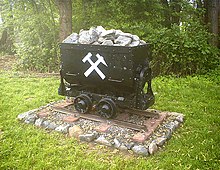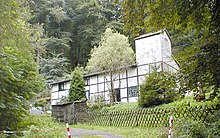Porta iron ore mine
| Porta iron ore mine | |||
|---|---|---|---|
| General information about the mine | |||
| Mining technology | Underground mining | ||
| Information about the mining company | |||
| Operating company | Ore mining at Porta-Damme | ||
| Employees | 330 | ||
| Start of operation | 1935 | ||
| End of operation | 1967 | ||
| Funded raw materials | |||
| Degradation of | Iron ore | ||
| Greatest depth | -23m above sea level | ||
| Geographical location | |||
| Coordinates | 52 ° 16 '16 " N , 8 ° 51' 44" E | ||
|
|||
| Location | Dützen | ||
| local community | Minden | ||
| District ( NUTS3 ) | Minden-Lübbecke | ||
| country | State of North Rhine-Westphalia | ||
| Country | Germany | ||
| District | Mindener district | ||
The Porta iron ore mine was a mine in the Wiehen Mountains south of the East Westphalian city of Minden on the Porta Westfalica . In the company, which existed from 1935 to 1967, the one to two meter thick , iron ore-bearing Wittekinds seam was mined, this forms the top layer of the porta sandstone .
history
The history of the Porta ore mine goes back to 1935, when Klöckner-Werke AG investigated the so-called Wittekinds seam in the Wiehen Mountains as part of the self-sufficiency efforts in experimental mining .
The Wiehengebirge is a low mountain range that extends from the western valley section (the Porta-Westfalica) of the Weser into the Osnabrück region. Not far from there is the city of Minden, which today includes parts of the ore mining area due to the Bielefeld law . Other parts are on the grounds of the cities of Porta Westfalica and Bad Oeynhausen .
Due to funding programs at the beginning of the 3rd Reich, interest in mining in the Wiehen Mountains near Minden increased again. By taking over Georgsmarienhütte, Klöckner Werke AG acquired the fields lent for mining . Preliminary dismantling began in 1935 with a trial operation . The company was located on the Königsberg in Minden-Häverstädt , the new tunnel was excavated only a few meters, a little below the old Königsberger tunnel .
The new Häverstädter tunnel reached the Wittekinds seam at 100.5 meters at Christmas 1935. From there, the bottom of the tunnel was driven in an easterly and westerly direction , and some of the huts were used for ventilation . The profitability of the operation there had now been rated so high that it was planned to excavate another tunnel near Dehme in order to develop the seam of the valley floor via a lower base section at about 55 meters above sea level .
The tunnel near Dehme was christened the Weserstollen, a little further up on the southern slope, at about + 155m above sea level the Wittekind tunnel was opened. From then on, the Weser tunnel served as the main weather, conveying and drainage tunnel. Initially, the ore was conveyed from the Wittekinds tunnel down to the Weser tunnel in the area of today's B 61 by means of a cable car . Later this should be done through the new main conveyor tunnel, the Peckeloh tunnel.
The then German government demanded higher domestic funding. The circumstances of the Eisenerzzeche Porta led to the plan to build a large plant with an annual output of 2 million tons. Without further ado, a union was founded to take over the company. From then on, the company continued to operate under the name Eisenerzzeche Union Porta.
In order to reach the desired destination of a large mine in the Wiehengebirge near Minden, various tunnels were excavated in a very short time. At the level of the lower basic section , the Weser tunnel sole, from 1937 to 1940 the 730 m long Peckeloh tunnel, which reached below the site of today's Potts-Park, at the level of the upper basic section, the Häverstädter tunnel sole in 1937 and 1938, the approximately 215 m long Dützer -Tollen and the approximately 260 m long Biemker tunnel in Minden-Haddenhausen. In 1941, the last 130 m long memorial tunnel was added on the south side of the mountain.
During the construction phase of the large mine, the Dützer tunnel served as the main conveyor tunnel after its completion from 1938 until the Peckeloh tunnel was completely excavated in 1940, at the mouth of which the new outer buildings of the mine were also built. In order to reach the Wittekindsflöz (the ore-containing layer in the Wiehengebirge) below the mountains, a shaft was also planned . So they wanted to mine the seam in civil engineering over two basic stretches or tunnel floors.
In 1938 one began with the depths of the first shaft. In 1939 it had reached its final depth of 317 m. The first underground level was already partially excavated and the second was in progress when the entire shaft was flooded by a sudden water ingress on the first underground level. After that, the focus was on mining the two basic routes. The Wittekindsquelle near the Wittekindsburg also dried up due to the water ingress into the shaft .
The existing tunnels were now increasingly being mined. Due to the war, the annual production fell from around 600,000 t to 20,000 t. Nevertheless, the mine employed around 500 workers. After a short break due to the war, production continued in the early 1950s. The number of employees had in the meantime shrunk to around 330, but it was enough to achieve 50% of the 600,000 t annual output.
In the Barkhausen area, for example, an underground excavation level was driven from 1957 , which was further north below the level of the Weser tunnel sole. However, there was no major mining in this area, since the great crisis in German ore mining began at the end of the 1950s and the mining of lower-quality ores was no longer profitable. It was shut down in 1962. At Dützer-Berg, sand-lime bricks were mined from 1961 to 1967, both below and above ground .
Ore mining at the Porta today
The last mine in the Minden mining area that is still producing today is Barbara Erzbergbau GmbH in Porta Westfalica- Nammen , with the Wohlverwahrt-Nammen mine . Incidentally, the ore mine in Nammen is not only the last in the region, but also the last remaining iron ore mine in Germany.
At the beginning of 2008, the managing parent company, Barbara Rohstoffbetriebe GmbH , was largely relocated from Nammen to Langenfeld . The Barbara ore mining GmbH went in 2003 from the Rohstoffbetriebe GmbH indicates the ore mining GmbH was familiar from now on with the active operation and Rohstoffbetriebe GmbH, is responsible since then only for administrative and legal succession, ie legacy. The Barbara ore mining GmbH was sold in late 2006 to the quarry operator Wesling who promises the new active mining at the Porta Westfalica upswing. Since April 7, 2008, the siding of the Minden circular railways , which was closed in 1994, has been reactivated.
Relics of days gone by
Witnesses and testimonies from the past are not easy to find, trained eyes notice something every now and then while hiking. Today's "Potts Park" (amusement park) is probably the most obvious building from the mining era on the western bank of the Weser. A visitor mine was once planned here, but the idea was discarded after the opening of the visitor mine in Kleinenbremen - Porta Westfalica.
At the Wittekindsburg on the Dehmer side of the mountains there is the Wittekindsquelle , which has dried up due to mining , and near which there is a tunnel entrance that is still visible to hikers. Exploring old mines without an expert guide and special equipment is not advised against for nothing. You not only endanger your life very easily, you may also disturb the animal world that has developed there. The former entrances to the mine are now Porta by the mining authority has been closed Kamen; so nobody can injure themselves in the old systems.
Along the hiking trails through the forests of the Wiehengebirge you can still find a piece of mining history here and there, such as a walled-up tunnel mouth hole or an old weather shaft.
All day openings were closed as already described; this leaves posterity only with memories in the form of preserved day-to-day facilities, documents and photos.
In the Potts Park (leisure park) in Minden-Dützen, large parts of the former outdoor facilities of the ore mine have been preserved. Some of the mine buildings are now the park's attractions, the other monuments of mining history, such as the administration or crusher building, can only be viewed from the outside.
On the Königsberg in Minden-Häverstädt, interested hikers in the Weser and Wiehen Mountains can still find some of the old mine buildings from the beginnings of 1935. The compressor building is very well preserved and has been converted into a residential building. Unfortunately, this relic of bygone days stood empty for several years, which did not improve its condition. As a result of this and for an unexplained cause, the severely dilapidated building burned to the ground on August 30, 2011. The workshop and the small Steigerhaus are slowly falling into disrepair.
While hiking on the south side in Dehme, you come across the remains of the foundations of the cable car that once transported the ore to the trucks on the road. Many motorists can recognize its lowest part on the B61, here there are still concrete remains in a small parking lot.
From the line of the Reichsbahn, which led to the Porta ore mine, there is not even a rail left, but a bridge over the Weser, as well as a bridge over Portastraße in Barkhausen and part of the railway line in the form of a dam in Häverstädterfeld. The former train station is still a bit out of the way in Häverstädt and houses a number of companies and apartments.
swell
- Hans Röhrs : ore and coal. Mining and ironworks between Ems and Weser . Ibbenbürener Vereinsdruckerei (IVD), Ibbenbüren 1992, 263 pages, ISBN 3-921290-62-7
- Rainer Slotta : Technical monuments in the Federal Republic of Germany 5/1 -1986, ISBN 3-921533-37-6
- Barbara Erzbergbau GmbH (website -Grube Wohlverwahrt-Nammen)
- Barbara Rohstoffbetriebe GmbH (Porta Westfalica branch)
- City of Minden (website)
See also
- Ore mining at Porta-Damme
- Damme iron ore mine
- Mindener district
- List of mines in North Rhine-Westphalia





